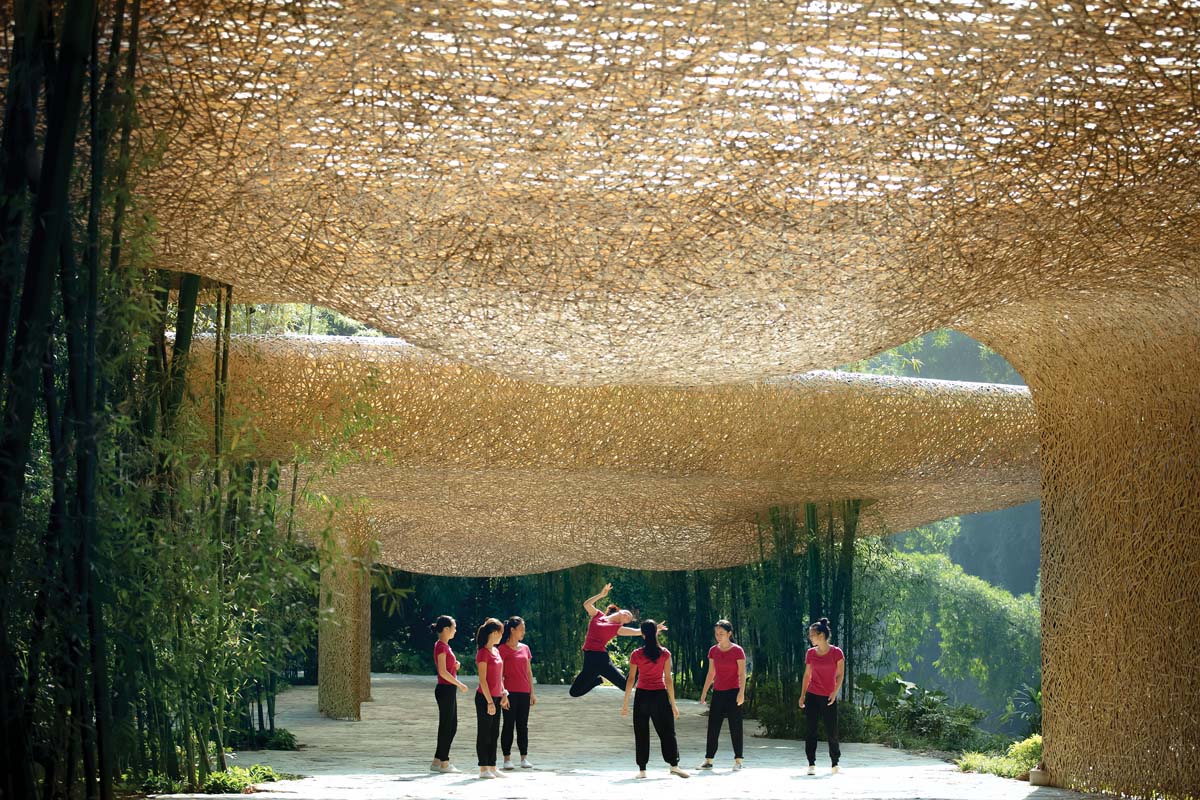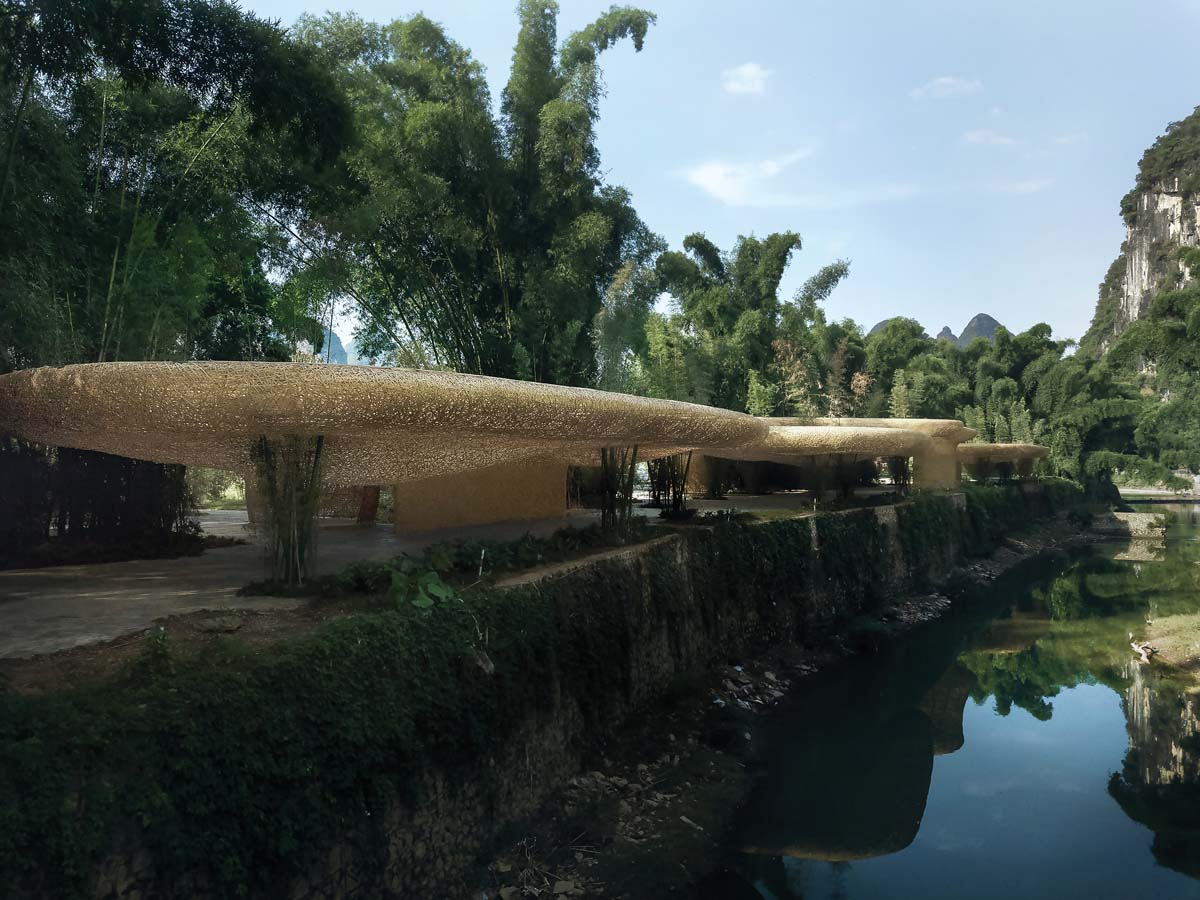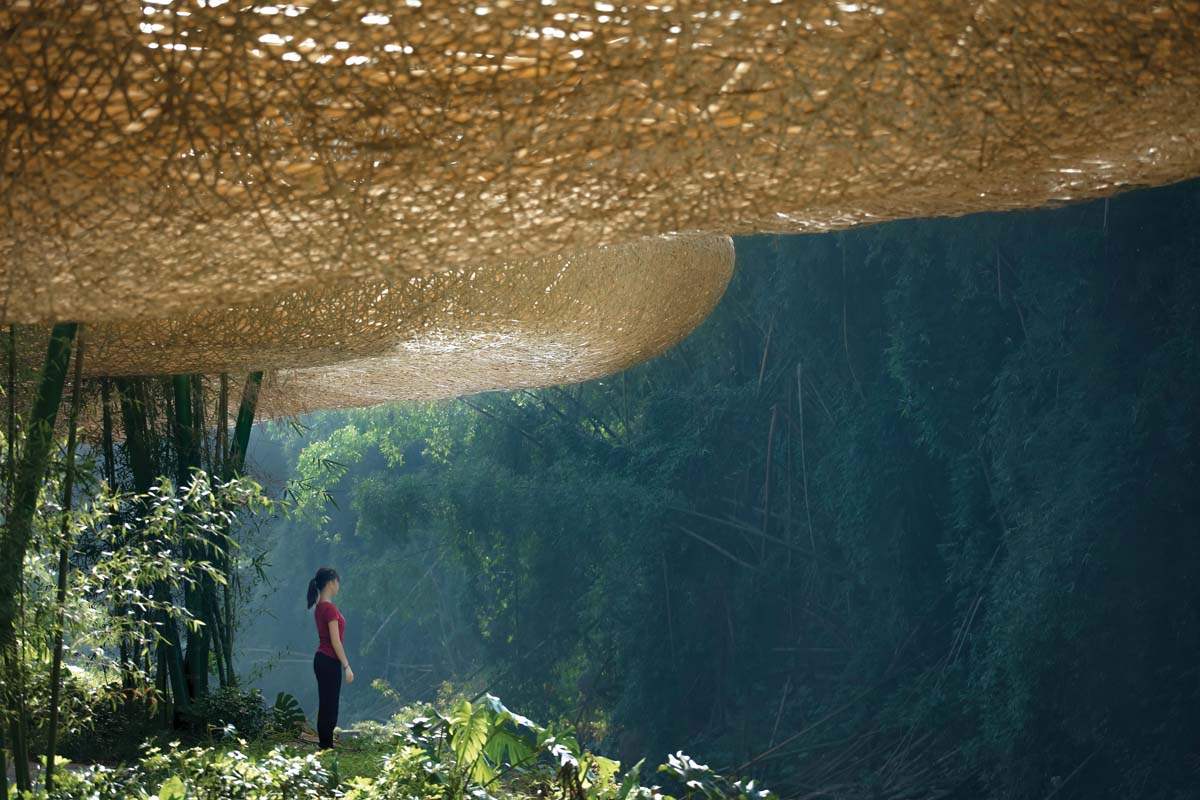Making an Entrance: Bamboo Bamboo, Yangshuo, Guilin, China
A sequence of woven-bamboo canopies and walk-through lanterns, designed by part-Canadian design group llLab, is the stunning lead-in to an island theatre show in China.

PROJECT Bamboo Bamboo, Yangshuo, Guilin, China
DESIGNER llLab
PHOTOS arch-exist photography
As frequent concertgoers know, you’ve scored a double bang for your buck when your show’s opening act turns out to be stellar. If you’re lucky, you could be rocking out even before the headliner enters the stage.
But what happens if the supporting act is a sequence of architectural moves, rather than a band? Can a display of design agility heighten an audience’s pre-show mood and anticipation? If a recent bamboo pavilion designed by part-Canadian design group llLab (pronounced “el el lab”) is any indication, the answer is a standing ovation.
Located on an island bifurcating the Li River in Guilin, China, the project is impossible to ignore. It’s the new grand entry to Impression Sanjie Liu, a huge open-air theatre set in a singular karst landscape with cliffhanging bamboo and river-etched valleys. Composed of a sequence of woven-bamboo canopies and walk-through lanterns, llLab’s pavilion is the first thing you see when you arrive on the island to take in Impression Sanjie Liu’s signature nighttime dance-theatre show. (The group and its show are inspired by the ballads of Sanjie Liu, a songstress from Chinese legends.) llLab’s arrangement draws you in, literally and figuratively, and whether you focus on its details or zoom out to its placement in nature, it doesn’t take long to realize why the pavilion won the ArchDaily award for Small Project of the Year in 2021.
llLab is a truly global practice: partners David Correa, Hanxiao Liu, Luís Ricardo and Taichi Kuma are based respectively in Toronto, Shanghai, Porto and Tokyo. The client brief, Correa says, called for an intervention that would open the imagination of theatregoers as soon as they got to the island. When audiences arrived before, they disembarked at a bus stop that did nothing to enhance the theatrical experience. So llLab proposed a transition zone with a performative dimension—a pathway that surprises and delights even before the show gets underway.

The outcome is an installation that invites engagement. It’s made up of four undulating canopies, each seemingly propped up by clusters of bamboo, and four lanterns large enough to stand inside and walk through. These elements—as well as smaller lanterns placed along the pathway for illumination—are made by encasing (and concealing) slender metal structural supports in an ethereal layer of woven bamboo strips, like draping canvas over and around tent poles. The bamboo for the project was harvested in the immediate surroundings, while the engineering behind the design stems from the team’s interdisciplinary background. Correa teaches bio-inspired design, digital manufacturing, and robotic wood fabrication at the University of Waterloo; he and Kuma studied computational design and construction at the University of Stuttgart. (Ricardo, Liu and Correa met while working at haascookzemmrich Studio 2050, a local architecture practice.) Ultimately, the design relies as much on a meeting of nature and artifice as it does on old ideas meshing with new concepts.
“In China, there’s an appetite for finding new expressions that draw on Chinese culture rather than on Western sensibilities,” says Correa. “Cities, towns and corporations want structures, spaces and visual identities that tell a story of who they are. They want something that feels new, but that is not foreign.” Impression Sanjie Liu was no exception. The bamboo pavilion draws heavily from regional bamboo weaving techniques that have been perfected over centuries, giving it a decidedly local feel. And while the shapes of the canopies and lanterns may be a novel addition to the landscape, they sit comfortably in their geographical context. As such, the pavilion offers a direct link to the region’s history and dramatic topography. More to the point, it creates a tangible path to its rich cultural tradition in narrative theatre.

When it comes to ways of doing things in China, Correa says design and fabrication are not far apart. It’s not unusual for a firm getting a commission for a chair to also manufacture it. “It’s a very dynamic design process,” he adds. “The timeline between acceptance of a design to completion is very short, and once a project starts, [clients] want it ready tomorrow.”
At one point, llLab sent a rendering of the bamboo pavilion to the client for review, and a week later, it was already in construction—even though the design was not yet final. But this fits in with Correa’s penchant for “happy accidents”: a lack of complete control that mimics nature. “This was the first time we worked with bamboo,” he says. “There are many species of bamboo, and unlike working with dimensional lumber, every piece is different. It is critical to find ways to manage some of its unpredictable behaviour on a project.” After much modelling and prototyping, llLab came up with the idea of using a minimal steel structure as a skeleton for the canopies and lanterns. This also allowed each component to be slightly different, lending the project an organic feel.

The result is a succession of lightweight structures that neither competes with nor outshines the stunning landscape. Rather, it forms a sheltered geography that serves as a place to look out and wonder at the surroundings—and to build excitement for the main act at the end of the pathway. Still, the bamboo pavilion in Guilin has also become an attraction in its own right, and to the delight of people coming to see a show of spectacular proportions, they’ve scored a surprise opening act. Talk about making an entrance.
Susan Nerberg is a writer and editor based in Montreal.
CLIENT Impression Sanjie Liu | DESIGN TEAM Hanxiao Liu, Henry D’Ath, Lexian Hu, Alyssa Tang, Chaoran Fan, Luis Ricardo, David Correa | CONTRACTOR GCPS Interior Decoration Finishing Ltd. | PROJECT MANAGEMENT Lihua Mi, Dalin Chai, Hao Zhang, Guoyang Wan | STRUCTURAL Lalu Partners Structure Consulting | BAMBOO LANTERN, BAMBOO WEAVING TECHNIQUE, STRUCTURAL RESEARCH MANAGEMENT Shanghai Tan Tan Props Ltd. | RESEARCH TEAM Qimin Cui, Geng Meng | BAMBOO LANTERN, BAMBOO WEAVING AND STRUCTURAL INSTALLATION Shanghai JD Bamboo Architectural Design & Engineering Ltd. | GROUND PAVING EXECUTION Haiming Liu, Jing Liu, Changfa Cai, Hequan Yu, Huofeng Liang, Daizhong Yu, Xiuping Tao, Baoxing Li, Ruoque An | AREA 1,900 m2 | BUDGET ¥8 M | COMPLETION July 2020
